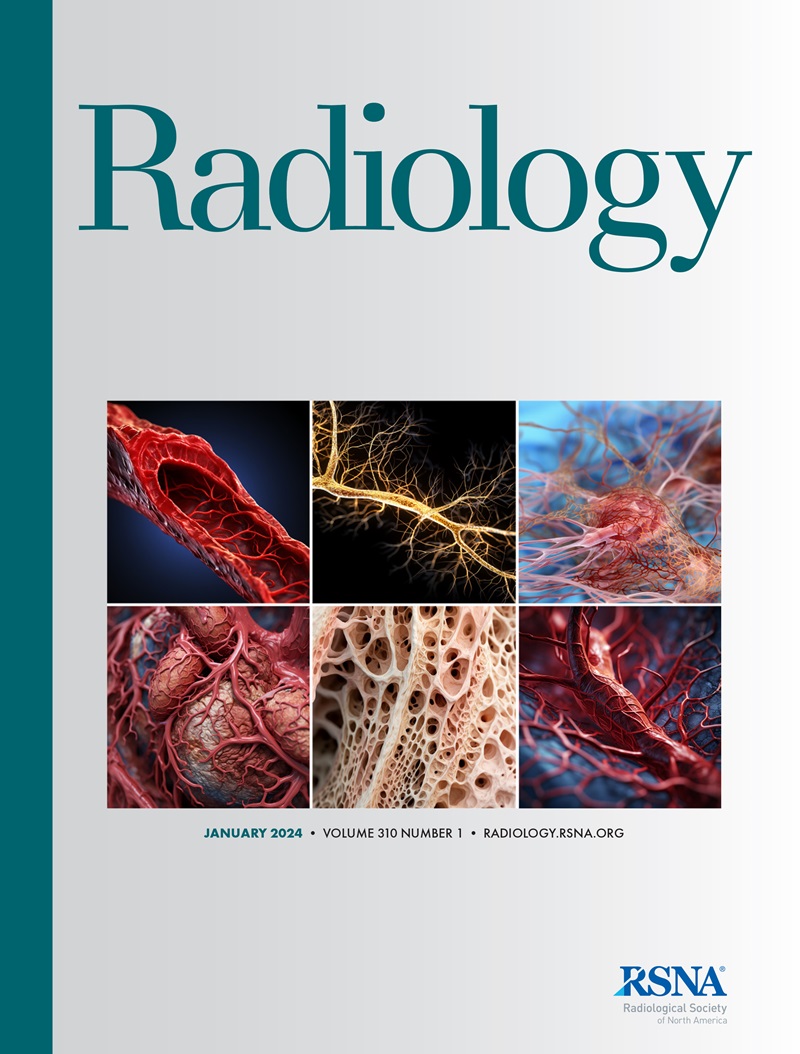Yura Ahn, Eun Ji Lee, Jihye Yun, Hye Jeon Hwang, Yeon-Mok Oh, Myeong Jun Kim, Seung Bin Bae, Donghoon Yu, Jaeyoun Yi, Sang Min Lee, Joon Beom Seo
求助PDF
{"title":"Longitudinal Tracking of Emphysema Holes at Noncontrast CT: Dynamic Patterns and Clinical Relationships.","authors":"Yura Ahn, Eun Ji Lee, Jihye Yun, Hye Jeon Hwang, Yeon-Mok Oh, Myeong Jun Kim, Seung Bin Bae, Donghoon Yu, Jaeyoun Yi, Sang Min Lee, Joon Beom Seo","doi":"10.1148/radiol.243239","DOIUrl":null,"url":null,"abstract":"<p><p>Background Emphysema holes change longitudinally in various ways, but current CT measurements lack the ability to fully capture these changes beyond measuring the extent of emphysema. Purpose To track emphysema holes longitudinally, group them according to their dynamics, and investigate their relationship with change in forced expiratory volume in 1 second (FEV<sub>1</sub>), disease progression, and mortality. Materials and Methods In this secondary analysis, data from participants in the Korean Obstructive Lung Disease cohort study from June 2005 to October 2013 who completed baseline and 6-year follow-up CT with identical protocols were evaluated. Emphysema holes were identified and tracked using deep learning-based software and were grouped based on changes in diameter (in 2-mm increments) as increased in diameter (including both new and enlarged preexisting holes), stable, or decreased in diameter. The percentage of hole volume in each group and its relationship with FEV<sub>1</sub> decline were analyzed using multiple linear regression, and comparisons were made among the subsets of participants on the basis of emphysema progression or severity. Overall survival according to the volume cutoff of the holes with increased diameter was compared using the log-rank test. Results Among 108 participants (mean age, 63.4 years ± 6.7 [SD]; 104 male), 39 had emphysema progression (based on whether the change in low-attenuation area less than -950 HU [LAA-950] exceeded 3.7%). Enlarged preexisting holes were marginally associated with a greater decline in FEV<sub>1</sub> (β = -.25, <i>P</i> = .049). Compared with those without emphysema progression, those with emphysema progression had a significantly greater percentage of hole volume and percentage of holes with increased diameter (7.7% vs 1.9% and 18.3% vs 6.2%, respectively; both <i>P</i> < .001), with most of the volume attributed to new holes. Participants with severe disease or emphysema (FEV<sub>1</sub> < 50% or LAA-950 ≥ 14%) had more holes with increased diameter (5.1% vs 2.4% [<i>P</i> = .02] and 6.7% vs 1.2% [<i>P</i> < .001], respectively) and new holes (3.8% vs 1.7% [<i>P</i> = .01] and 4.7% vs 1.1% [<i>P</i> < .001], respectively). Participants with 5% or greater volume of increased-diameter holes had worse overall survival (log-rank <i>P</i> < .001). Conclusion Emphysema hole-tracking results showed that a greater volume of holes that increased in diameter were related to change in FEV<sub>1</sub>, disease progression, and mortality. © RSNA, 2025 <i>Supplemental material is available for this article</i>. See also the editorial by van Beek in this issue.</p>","PeriodicalId":20896,"journal":{"name":"Radiology","volume":"316 1","pages":"e243239"},"PeriodicalIF":12.1000,"publicationDate":"2025-07-01","publicationTypes":"Journal Article","fieldsOfStudy":null,"isOpenAccess":false,"openAccessPdf":"","citationCount":"0","resultStr":null,"platform":"Semanticscholar","paperid":null,"PeriodicalName":"Radiology","FirstCategoryId":"3","ListUrlMain":"https://doi.org/10.1148/radiol.243239","RegionNum":1,"RegionCategory":"医学","ArticlePicture":[],"TitleCN":null,"AbstractTextCN":null,"PMCID":null,"EPubDate":"","PubModel":"","JCR":"Q1","JCRName":"RADIOLOGY, NUCLEAR MEDICINE & MEDICAL IMAGING","Score":null,"Total":0}
引用次数: 0
引用
批量引用
Abstract
Background Emphysema holes change longitudinally in various ways, but current CT measurements lack the ability to fully capture these changes beyond measuring the extent of emphysema. Purpose To track emphysema holes longitudinally, group them according to their dynamics, and investigate their relationship with change in forced expiratory volume in 1 second (FEV1 ), disease progression, and mortality. Materials and Methods In this secondary analysis, data from participants in the Korean Obstructive Lung Disease cohort study from June 2005 to October 2013 who completed baseline and 6-year follow-up CT with identical protocols were evaluated. Emphysema holes were identified and tracked using deep learning-based software and were grouped based on changes in diameter (in 2-mm increments) as increased in diameter (including both new and enlarged preexisting holes), stable, or decreased in diameter. The percentage of hole volume in each group and its relationship with FEV1 decline were analyzed using multiple linear regression, and comparisons were made among the subsets of participants on the basis of emphysema progression or severity. Overall survival according to the volume cutoff of the holes with increased diameter was compared using the log-rank test. Results Among 108 participants (mean age, 63.4 years ± 6.7 [SD]; 104 male), 39 had emphysema progression (based on whether the change in low-attenuation area less than -950 HU [LAA-950] exceeded 3.7%). Enlarged preexisting holes were marginally associated with a greater decline in FEV1 (β = -.25, P = .049). Compared with those without emphysema progression, those with emphysema progression had a significantly greater percentage of hole volume and percentage of holes with increased diameter (7.7% vs 1.9% and 18.3% vs 6.2%, respectively; both P < .001), with most of the volume attributed to new holes. Participants with severe disease or emphysema (FEV1 < 50% or LAA-950 ≥ 14%) had more holes with increased diameter (5.1% vs 2.4% [P = .02] and 6.7% vs 1.2% [P < .001], respectively) and new holes (3.8% vs 1.7% [P = .01] and 4.7% vs 1.1% [P < .001], respectively). Participants with 5% or greater volume of increased-diameter holes had worse overall survival (log-rank P < .001). Conclusion Emphysema hole-tracking results showed that a greater volume of holes that increased in diameter were related to change in FEV1 , disease progression, and mortality. © RSNA, 2025 Supplemental material is available for this article . See also the editorial by van Beek in this issue.
非对比CT对肺气肿空洞的纵向追踪:动态模式和临床关系。
背景:肺气肿孔洞以各种方式纵向变化,但目前的CT测量缺乏完全捕捉这些变化的能力,只能测量肺气肿的范围。目的对肺气肿孔进行纵向跟踪,并根据其动态进行分组,探讨其与1秒用力呼气量(FEV1)变化、疾病进展及死亡率的关系。材料和方法在这项二级分析中,对2005年6月至2013年10月韩国阻塞性肺疾病队列研究中完成基线和6年随访CT的参与者的数据进行评估。使用基于深度学习的软件识别和跟踪肺气肿孔,并根据直径的变化(以2mm的增量)分为直径增加(包括新的和扩大的先前存在的孔),稳定或直径减少进行分组。采用多元线性回归分析各组气孔体积百分比及其与FEV1下降的关系,并根据肺气肿进展或严重程度在参与者亚群之间进行比较。根据直径增大的孔的体积切断量,采用对数秩检验比较总存活率。结果108例受试者(平均年龄63.4岁±6.7 [SD];男性104例),肺气肿进展39例(以低衰减区< -950 HU [LAA-950]变化是否超过3.7%为标准)。先前存在的孔洞扩大与FEV1的较大下降略有相关(β = -)。25, p = .049)。与没有肺气肿进展的患者相比,肺气肿进展患者的孔洞体积百分比和孔洞直径增加百分比分别为7.7% vs 1.9%和18.3% vs 6.2%;P < 0.001),大部分体积归因于新孔。严重疾病或肺气肿(FEV1 < 50%或LAA-950≥14%)的参与者有更多直径增加的孔(分别为5.1%对2.4% [P = .02]和6.7%对1.2% [P < .001])和新孔(分别为3.8%对1.7% [P = .01]和4.7%对1.1% [P < .001])。有5%或更大体积直径增大的孔的参与者的总生存率较差(log-rank P < 0.001)。结论肺气肿空洞追踪结果显示,肺气肿空洞体积增大、直径增大与FEV1的变化、疾病进展和死亡率有关。©RSNA, 2025本文可获得补充材料。参见范·比克在本期的社论。
本文章由计算机程序翻译,如有差异,请以英文原文为准。

 求助内容:
求助内容: 应助结果提醒方式:
应助结果提醒方式:


